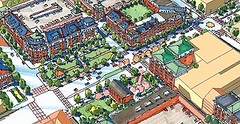Today’s review article examines the question of human behaviour, specifically what best encourages behaviour in support of the “New Urbanism” - the design of the city or the attitudes of those who chose to live in such a city i.e. “structures vs. “attitudes” The answer may surprise some who believe in the value of good urban design.
Key Quotes:
“New Urbanism refers to a form of development that integrates shopping and housing in a pedestrian friendly environment that reduces the need for automobile usage and arguably impacts individual choices regarding commuting and other daily travel”
Questions:
- "Does New Urbanist design as a specific structural form reduce resident’s reliance on automobiles?"
- "Do individuals who choose to buy homes in New Urbanist communities already share ecological attitudes that predispose them to use alternative modes of transportation?”
“Los Angeles is a sprawling region that includes nearly 100 urban and suburban centers, whose growth was determined almost entirely on the basis of widespread and sustained automobile usage”
“With respect to biking/walking and mass transit, we find a positive and significant relationship. As use of alternative forms of transit increases, driving increases as well! In other words, alternative modes of transportation are not substitutive in this model, but rather synergistic”
“better educated people are less likely to walk, and that increased family size leads to greater use of mass transit (possibly because of non-driving children in a household)”
“we conclude that ecological attitudes may be more important than urban design with respect to modifying individuals’ behavior to protect and/or preserve the natural environment”
“[t]he ability of physical design to solve social problems outright is a far more ambitious proposal, and the history of planning has shown repeatedly that this approach has had limited success.”
Related articles
- New urbanism, landscape urbanism, and the future of settlements (energybulletin.net)
- Green building (boston.com)
- Ideas: A fight is growing in urban planning (boston.com)
- New course in urban design tackles gap in expertise (postgrad.com)
- Friday 5: Articles for Urbanists [Jan 29th-Feb 4th] (yuriartibise.com)
- Urban Physics (pollutionfree.wordpress.com)
- How urban design is making our cities more verdant, walkable, and sociable. (slate.com)


No comments:
Post a Comment